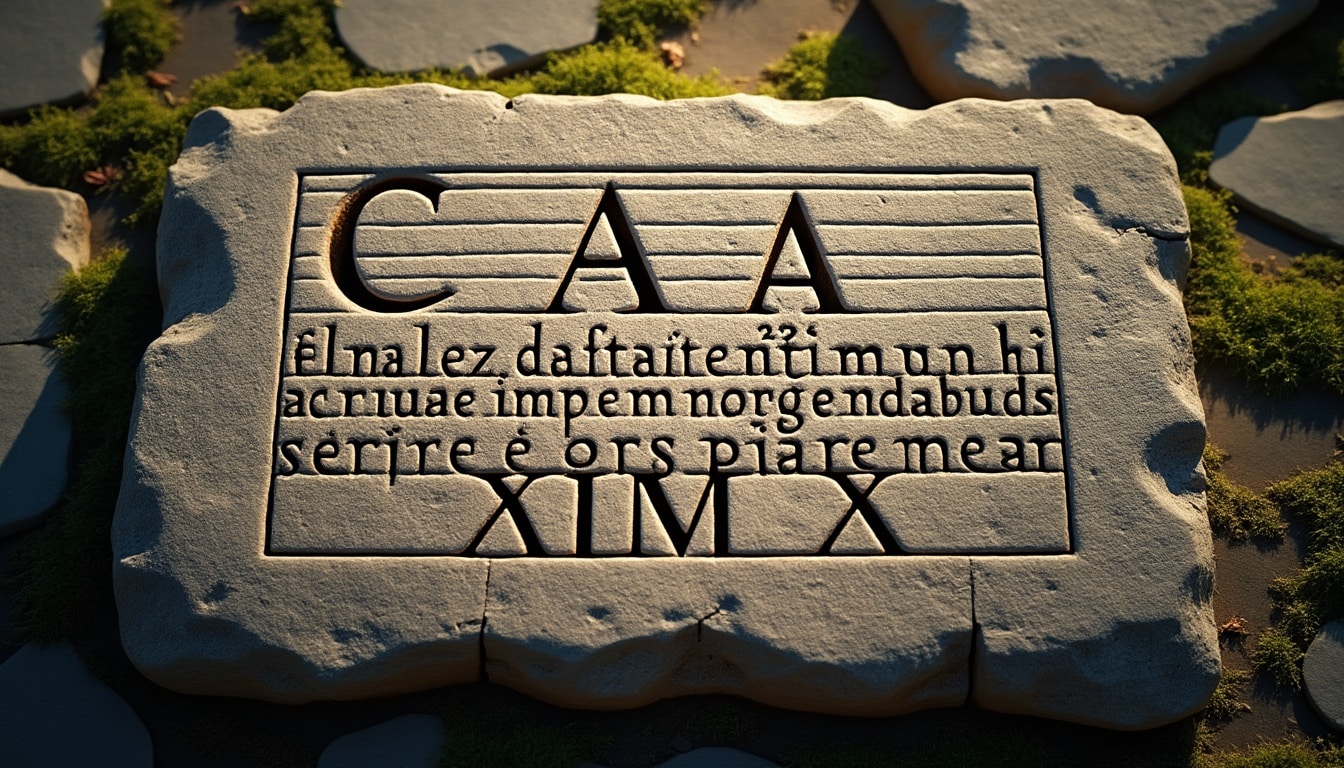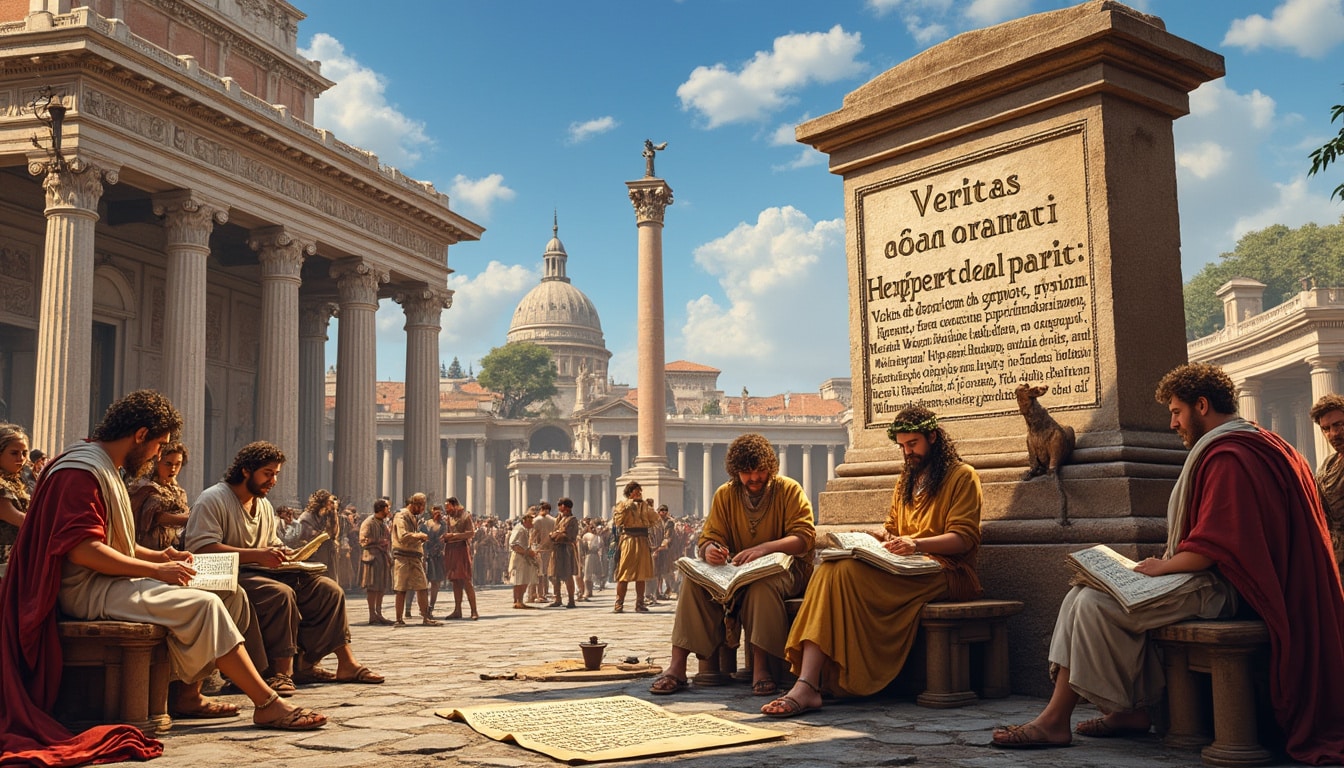In the heart of Italy lies Rome, the Eternal City, with a rich linguistic tapestry that spans from the ancient era to the bustling present. Known for its historical landmarks and vibrant culture, Rome’s linguistic evolution is a journey through time. From the grandeur of Latin, the language of the ancients, to modern Italian, alongside a medley of tongues from around the globe, this city’s language speaks volumes about its cultural identity and historical significance. But how did Rome’s language evolve over centuries, and what influences shaped its unique characteristics? Let us explore Rome’s fascinating linguistic heritage, taking a closer look at the elements of its lingua, grammatica, and scriptura.
The Lingua Franca of Ancient Roma: Latin’s Enduring Legacy
The story of Rome’s linguistic heritage begins with Latin, the classical language that once united the sprawling Roman Empire. As the original language of Roma, Latin served as the foundation for not only the city’s cultural and political institutions but also for what would become the Romance languages of Europe. It was more than just a means of communication; it became a verbo of power and civilization.
- 🕰️ Antiquity’s Voice: Latin was used in administration, law, and literature, deeply embedding itself into the heart of Roman culture.
- 🌎 Global Influence: Latin’s reach extended far beyond the borders of Rome, influencing languages across the globe.
- 📜 Classical Texts: Iconic works like Virgil’s “Aeneid” and Cicero’s orations were penned in Latin, shaping literary traditions.
Latin’s influence is visible today, not just in the lexicon of modern languages but in the very structure of Western education and scholastic methods. The grammatica of Latin laid the groundwork for language study, with its systematic approach to ortografia and calligrafia offering insights into ancient cultural practices. Indeed, the decline of spoken Latin didn’t erase its significance; rather, it evolved into new dialects that spread across the European continent, leading to the development of Italian, French, Spanish, and more.
Latin’s role as a liturgical language, especially within the Catholic Church, underscored its eternal influence, with its teachings and texts enduring in religious communities. Despite its historical transformations, Latin remains a touchstone of scholarly pursuits in scriptura and educational curricula worldwide.

Latin and Modern Language Development
To appreciate Latin’s impact, consider how many modern-day professional terminologies—legal, medical, botanical—originate from Latin roots. Its precision and adaptability have made it a language of choice in sciences and arts alike. Moreover, Latin phrases continue to pervade legal systems and academic traditions, underscoring the lasting legacy of Rome’s original >parola<.
Transformation and Triumph: The Rise of Italian
By the end of the medieval period, Latin had gradually metamorphosed into Italian, marking a significant shift in Rome’s linguistic landscape. This transformation was neither abrupt nor uniform; it was an organic process shaped by the cultural and social dynamics of the Renaissance.
- 🎨 Renaissance Revival: The rebirth of art and science during the Renaissance was mirrored by the evolution of a modern Italian language emerging from Latin roots.
- 📚 Florentine Influence: The Florentine dialect, used by Dante, Petrarch, and Boccaccio, became the standard for what would become Tuscan, leading to the Italian language.
- 🏛️ Unified Communication: Italian served to unify diverse dialects and regional variations across the peninsula.
In 1861, with the unification of Italy, came the establishment of standard Italian as the national language. However, its adoption in daily life took decades, as local dialects continued to thrive. Italian became a symbol of national identity, representing a linguistic Renaissance that mirrored political and cultural rejuvenation.
Italian today does much more than serve functional purposes; it enriches interactions in both domestic and international contexts, reflecting a vibrant culture teeming with historical depth and artistic flair.
Recognized as the language of love, art, and music, Italian has a romantic allure that captivates learners worldwide. The eloquence of its expressions and the rhythm of its structure make it unique, contributing to its role not just as a tool of communication, but as a cultural symbol of Rome.
The Continuing Influence of Italian
In modern Rome, Italian remains paramount in administrative, educational, and cultural settings. Influences from global migration and trade have introduced additional languages, positioning Rome as a polyglot metropolis. English, for instance, is increasingly prevalent in business and tourism, underscoring Rome’s status as a global city.
Beyond Borders: Multilingual Rome in the 21st Century
While Italian stands as Rome’s official language, the city’s linguistic fabric is far more complex, with over a million speakers communicating in myriad tongues. This reflects Rome’s historical role as a crossroads of cultures and its position as a center of immigration and trade. Today, immigrants from Romania, China, and North Africa contribute to a linguistic mosaic that defines modern Rome.
- 🌍 Global Linguistica: Languages like Romanian, Arabic, and Mandarin have found their niches, underscoring Rome’s multicultural identity.
- 📈 Demographics and Diversity: The dynamic demographic landscape influences cultural and linguistic exchanges in everyday life.
- 🛍️ Tourism and Trade: The influx of international visitors necessitates a multilingual approach to business, particularly in tourism and commerce.
This linguistic diversity challenges traditional narratives of a monolingual nation, encapsulating the spirit of a city that celebrates diverse voices. For a deeper understanding of Rome’s demographics and the impact on its language and culture, you can explore more on Rome’s demographics and geography.
The Role of Technology in Enhancing Linguistic Diversity
Globalization and digital communication tools have not only facilitated the spread of new languages but also fostered inclusivity. Language apps and digital translators bridge gaps for both residents and visitors, while social media platforms promote diverse cultural exchanges in real time.
Linguistic Education: Rome’s Road to Multilingual Mastery
Language education plays a pivotal role in ensuring that Rome’s linguistic heritage is preserved and enriched. With its historic universities and cultural institutions, the city offers numerous opportunities for language learning and intercultural engagement.
- 🎓 Academic Institutions: Prestigious universities and language schools in Rome provide platforms for learning Italian and a plethora of other languages.
- 📖 Cultural Immersion: Programs and exchanges that enable students to experience life in Rome enhance linguistic dexterity.
- 💼 Professional Advancement: Multilingual proficiency boosts employment opportunities in Rome’s diverse job market.
The city’s rich historical context provides an immersive backdrop for exploring calligrafia and scriptura, attracting language enthusiasts eager to delve into profound traditions. Meanwhile, government initiatives aim to promote bilingual and multilingual education, reflecting a commitment to linguistic diversity and cultural inclusivity.
Many learners head to Rome to immerse themselves in its vibrant culture and improve their Italian, thanks to numerous resources and language schools that cater to all proficiency levels. For those interested in exploring linguistic opportunities alongside culinary delights, a visit to Rome often includes delightful experiences with local meal times and celebrations.
Innovative Approaches to Language Education
Language education in Rome increasingly integrates technology to enhance learning experiences. From interactive apps to virtual reality excursions, technology aids educators in making learning an engaging and dynamic journey.
The Cultural and Historical Significance of Language in Rome
Language in Rome is not merely a tool of communication; it is interwoven with the city’s identity and cultural narrative. Over centuries, linguistic evolution shaped Rome’s political, social, and cultural landscapes, leaving an indelible mark on its heritage.
- 🏆 Cultural Heritage: Language preserves stories, traditions, and values, serving as a testament to Rome’s ancient roots.
- 🏺 Historical Influence: The strategic adoption and adaptation of languages have propelled Rome as a cultural epicenter over millennia.
- 🎭 Arts and Expressions: Whether in literature, theater, or art, language enables Rome’s vibrant artistic expressions to thrive.
Rome’s linguistic journey is characterized by the amalgamation of diverse influences that have enriched its artistic, philosophical, and scientific domains. These elements remain evident in today’s cultural and educational settings, from thriving contemporary art scenes to internationally renowned academic forums.
As language shapes the nuances of Rome’s daily life, its history as a melting pot of cultures is a reminder of the city’s ability to adapt and evolve. This adaptability allows Rome to remain a vibrant and dynamic cultural hub, attracting visitors and scholars eager to explore its unique blend of history and modernity. For those seeking more about Rome’s urban features and architectural marvels, information can be found on Rome’s urban features and architecture.
Spotlight on Literary and Artistic Movements
Throughout history, Rome has been a cradle for literary and artistic movements that have traversed linguistic boundaries. Examining these contributions offers insight into the city’s role as a cultural innovator, with language serving as the medium for expressing revolutionary ideas and social commentary.
FAQs About Language and Spelling in Rome
- What is the official language of Rome? Italian is the official language of Rome, reflecting the city’s deep historical ties to the foundation of the Italian state.
- Are there other languages spoken in Rome? Yes, alongside Italian, languages such as English, French, Romanian, Arabic, and Chinese are also commonly spoken due to immigration and international communities.
- How has technology impacted language learning in Rome? Technology has significantly enhanced language learning by providing digital tools and platforms that facilitate interactive and innovative educational methods.
- What role does language play in Rome’s tourism industry? Language is crucial in tourism, as multilingual services enhance communication and interaction with the diverse pool of international tourists visiting Rome.
- Why is Latin still significant in Rome today? Latin’s historical significance as the language of the Roman Empire and the Catholic Church maintains its status in educational, liturgical, and scholarly contexts.

